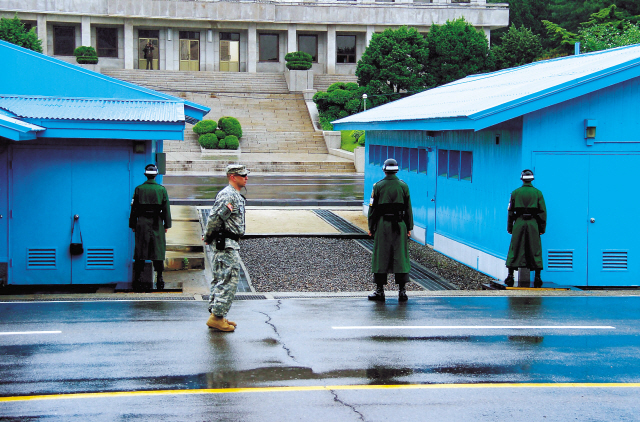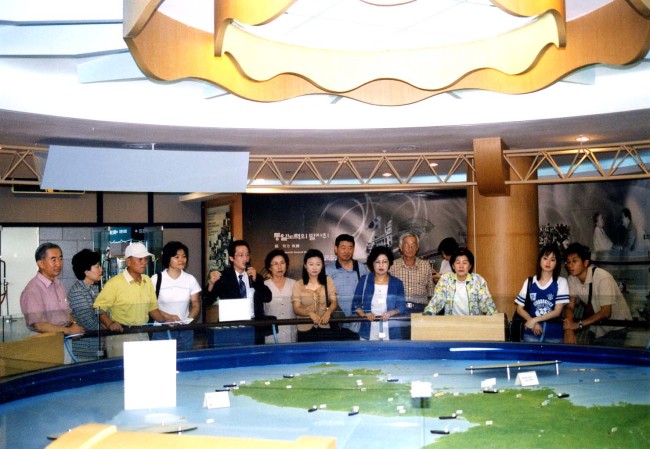Located within the Demilitarized Zone, the Joint Security Area is the most forward location that can be visited by people in South Korea.
It sits in the western portion of the DMZ on the Military Demarcation Line that divides the two Koreas according to the Korean Armistice Agreement of 1953. Also often referred to as a “Truce Village,” Panmunjeom, or the JSA as it is formally called, is where South and North Korean troops stand on guard, staring at one another from a distance. Although this year marks the 60th anniversary of the cease-fire, the two Koreas are technically still at war.
Just 62 kilometers northwest of the heart of Seoul, a mere one-hour bus ride away from the dynamic metropolitan area, lies the area that was once described by former U.S. President Bill Clinton as the “scariest place on Earth.”
It sits in the western portion of the DMZ on the Military Demarcation Line that divides the two Koreas according to the Korean Armistice Agreement of 1953. Also often referred to as a “Truce Village,” Panmunjeom, or the JSA as it is formally called, is where South and North Korean troops stand on guard, staring at one another from a distance. Although this year marks the 60th anniversary of the cease-fire, the two Koreas are technically still at war.
Just 62 kilometers northwest of the heart of Seoul, a mere one-hour bus ride away from the dynamic metropolitan area, lies the area that was once described by former U.S. President Bill Clinton as the “scariest place on Earth.”

A trip to the JSA is an experience like no other. With armed soldiers at every glance, the sounds of practice gunfire that echo through the air and where visitors receive warnings not to make any sudden movements or hand gestures to avoid any misunderstanding and conflicts among the North Korean soldiers. The tension is indescribable.
“The global perception of the peninsula is that a war could breakout at any minute,” said Kim Bong-ki, head of the Panmunjom Travel Center, located in Seoul. “Tours to the DMZ tend to conjure up feelings of fear, but there is no need.”
Kim hopes that PTC’s tours to Panmunjeom and the DMZ will give visitors an opportunity to learn about the current political and social situations in the two countries, especially the human rights violations in the North.
Unlike other tour agencies, the PTC offers participants the unique opportunity to speak with one of several North Korean defectors it has on its tour staff through its “DMZ Special Tour with North Korean Defector” package.

“It was surreal,” said Amy Jenkins, a U.S. traveler visiting the DMZ for the first time who specifically chose the North Korean defector tour because of the rare opportunity she would have to ask questions and hear a first hand account of life in the North.
“I didn’t know the details. The fact that it’s still happening now to this extent, I had no idea,” she said in response to hearing the defector’s stories on the extreme state of famine that caused her to flee her country.
“Everything about it was just so surreal,” said Jenkins.
“At one point my malnutrition was so severe, that even when I managed to find some scraps of food, I barely had the strength to eat,” said one of the tour’s North Korean defector speakers, who used the name “Nam,” in a one-on-one interview with The Korea Herald during the tour.
For 19 years, Nam served in the North Korean Navy in the city of Hamheung. Although she was employed in the Navy, she barely made enough money to put food on the table, and she, like many North Korean soldiers, was on the verge of dying of starvation.
Nam admitted to seeing countless military servicemen and women die from starvation every year. And despite serving her country for nearly two decades, she was eventually discharged due to her deteriorating health; she received no benefits and no compensation. Nam found herself left with nothing.
“I didn’t even know when my next meal would come,” she said. “My father died when I was young, so I was left to take care of my mother on my own. I soon realized that if I didn’t do something drastic, my mother and I were both going to starve to death.”
Nam decided to do what most North Koreans dare not do for fear of being captured and killed. She decided to flee the country and tracked down a smuggler to help her cross the border into China.
“I wanted to be free, I needed to be free,” said Nam.
After crossing the Yalu River into China, she quickly realized that she would never be safe there: In China, citizens receive a substantial reward for reporting and returning defectors back to North Korea.
“There are still a lot of people fleeing to China today, but it is becoming tougher and tougher not to get caught,” she explained.
Around the same time Nam managed to make her escape across the border to China, a tragic train accident occurred near her old village, killing more than 800 people. Many of the remains were dismembered and could not be identified. Nam’s mother found this to be a perfect opportunity to ensure her own safety and that of her daughter by submitting a death certificate for Nam, claiming that she was killed in the crash.
Nam continued her dangerous escape and journeyed for a year, making her way to Laos, Cambodia and Thailand before she was finally able to reach South Korea, where she has now been living for a year and four months.
“In North Korea, being able to work and eat is very difficult, but that’s not the case in the South,” she said. “I used to think that if I were able to have regular access to food, my life would be stress free; but it turns out I was wrong.”
The images of political democracy, social freedom and thoughts of a “better life” flooded her mind the year she spent making her way to the other side of the peninsula, but Nam still finds herself struggling to make ends meet.
“I’m here alone and making money is still very difficult for me,” she explained. “I have to make money for myself, but I also have to make enough to send to my family back in North Korea.”
Although she enjoys all the rights of full citizenship here, she is still treated as a foreigner; in many cases she is seen as the enemy and suffers from daily social discrimination.
“To be honest, there are times where I have regretted my decision to flee,” Nam said with tears streaming down her face. “I have been turned down for jobs on many occasions when I revealed to people that I am a defector.”
“A lot of times I just go home and cry and wonder why I came here. There are moments where I thought about going back China and trying to sneak back into my country, but since my mom had reported to the government that I died, I am stuck with the reality that I can never ever go back.”
Nam continues to try to make the best of her new life in Seoul, finding part-time work washing dishes and participating in PTC tours and jumps at every opportunity she can find to educate people about the North.
“I keep telling myself that if I just continue to stick with it and work hard, good things will eventually happen.”
By Julie Jackson (juliejackson@heraldcorp.com)
-
Articles by Korea Herald





![[KH Explains] No more 'Michael' at Kakao Games](http://res.heraldm.com/phpwas/restmb_idxmake.php?idx=644&simg=/content/image/2024/04/28/20240428050183_0.jpg&u=20240428180321)






![[Grace Kao] Hybe vs. Ador: Inspiration, imitation and plagiarism](http://res.heraldm.com/phpwas/restmb_idxmake.php?idx=644&simg=/content/image/2024/04/28/20240428050220_0.jpg&u=)







